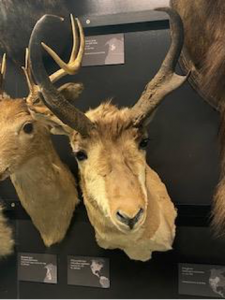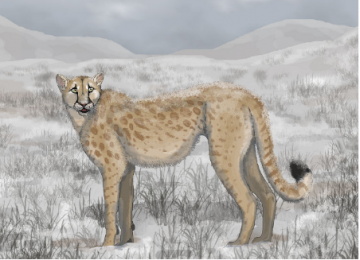Did you know North America is home to the second fastest land animal in the world?

Pronghorn specimen on display in the Beaty Museum
The pronghorn is a mammal native to the mid-western United States and Canadian prairies. It is distinguishable by its distinctive white patches along the underside of its belly and on its rump. The male pronghorn also has paired, forked horns which give the animal its name. These horns, along with the pronghorn’s large eyes make them resemble an antelope – giving it the other colloquial name of American antelope. While these morphological traits do give off that impression, the pronghorn is not related to antelopes! These similarities are most likely the result of parallel evolution. The question then is why did an animal from North America develop such similar traits to animals in areas with large, high-speed predators? The answer is in the past.
Fossil records show that in North America 10 000 years ago there was a predator that, like the pronghorn, had strikingly similar features to animals that live continents away. There have been fossils found of a light and slender-boned cat that once lived in the North American grasslands. This feline is the American cheetah.

Artists rendition of an American cheetah. Wiki Creative Commons license 4.0, https://creativecommons.org/licenses/by-sa/4.0/deed.en. Wiki poster: Sheatherius
The American cheetah is the word used for two different extinct species. They would have been about the size of a modern-day cougar – slightly larger than the modern cheetah. It is also believed that they had retractable claws and sturdier forelimbs which suggests that they may have also been climbers. Interestingly, they were more closely related to pumas or cougars than to modern-day cheetahs. Researchers have attributed this to convergent evolution. Although there is no way to know for certain, it is believed that these big cats were able to reach very high speeds while running. By looking at the predators of pronghorns in the modern day there is very little reason for them to have evolved to run at speeds of 92 km/hr but the American cheetah provides a plausible explanation.
Given this comparison, the American cheetah would have likely been specialized at sprinting to catch its prey which explains the high speeds that modern pronghorns can reach while running. The American cheetah likely went extinct from the changing climate in that period and out-competed other predatory felines. The two together provided an environment that was inhospitable for such a specialized predator.
This type of research continues to happen globally. This is an example of how researchers can use phylogeny to explore the pasts of our modern-day creatures and why studying fossils remains such an important, and fascinating field.
https://www.nwf.org/educational-resources/wildlife-guide/mammals/pronghorn
https://www.fossilhunters.xyz/disappeared-species/american-cheetah.html
By Paige Smallman, BBM Interpreter
